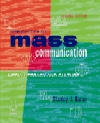Stanley J. Baran
| AIDA approach | the idea that to persuade consumers advertising must attract Attention, create Interest, stimulate Desire, and promote Action
|
 |
 |
 |
| ambient advertising | advertisements found outside the traditional media
|
 |
 |
 |
| awareness test | ad research technique that measures the cumulative effect of a campaign in terms of a product's "consumer consciousness"
|
 |
 |
 |
| banners | online advertising messages akin to billboards
|
 |
 |
 |
| blink ads | one-second spots in television advertising
|
 |
 |
 |
| brand awareness | an advertising goal when a number of essentially similar brands populate a given product category
|
 |
 |
 |
| cease-and-desist order | demand made by a regulatory agency that a given illegal practice be stopped
|
 |
 |
 |
| clutter | in television, when many individual commercials share one commercial break
|
 |
 |
 |
| commissions | in advertising, placement of advertising in media is compensated, at typically 15% of the cost of the time or space, through commissions
|
 |
 |
 |
| consumer culture | where personal worth and identity reside not in the people themselves but in the products with which they surround themselves
|
 |
 |
 |
| consumer juries | ad research technique where people considered representative of a target market review a number of approaches or variations of a campaign or ad
|
 |
 |
 |
| copy testing | measuring the effectiveness of advertising messages by showing them to consumers; used for all forms of advertising
|
 |
 |
 |
| corrective advertising | a new set of ads required by a regulatory body and produced by the offender that correct the original misleading effort
|
 |
 |
 |
| cost per thousand (CPM) | in advertising, the cost of reaching 1,000 audience members, computed by the cost of an ads' placement divided by the number of thousands of consumers it reaches
|
 |
 |
 |
| cyberadvertising | placement of commercials on various online sites
|
 |
 |
 |
| demographic segmentation | advertisers' appeal to audiences composed of varying personal and social characteristics such as race, gender, and economic level
|
 |
 |
 |
| extramercials | columns of ad content in cyberadvertising that slide down over a Web page's content
|
 |
 |
 |
| forced exposure | ad research technique used primarily for television commercials, requiring advertisers to bring consumers to a theater or other facility where they see a television program, complete with the new ads
|
 |
 |
 |
| intermercials | attractive, lively commercials that run while people are waiting for Web pages to download
|
 |
 |
 |
| interstitial ads | cyberadvertising images that seem to mysteriously appear and disappear on the screen as users click from one page to the next
|
 |
 |
 |
| newsbook | early weekly British publications that carried ads
|
 |
 |
 |
| parity products | products generally perceived as alike by consumers no matter who makes them
|
 |
 |
 |
| piggybacking | in television advertising, when a single sponsor presents two products in the same commercial
|
 |
 |
 |
| pop-outs | cyberadvertising that appears in a smaller window at the border of the Web page being read
|
 |
 |
 |
| psychographic segmentation | advertisers' appeal to consumer groups of varying lifestyles, attitudes, values, and behavior patterns
|
 |
 |
 |
| puffery | a little lie or exaggeration that makes advertising more entertaining than it might otherwise be
|
 |
 |
 |
| recall testing | ad research technique where consumers are asked to identify which ads are most easily remembered
|
 |
 |
 |
| recognition tests | ad research technique where people who have seen a given publication are asked whether they remember seeing a given ad
|
 |
 |
 |
| retainer | in advertising, an agreed-upon amount of money a client pays an ad agency for a specific series of services
|
 |
 |
 |
| shopbills | attractive, artful business cards used by early British tradespeople to promote themselves
|
 |
 |
 |
| siquis | pinup want ads common in Europe before and in early days of newspapers
|
 |
 |
 |
| targeted keyword buys | when a sponsor buys the right from an Internet service provider to have its ads pop up on the computer screen every time a user types in the sponsor's name
|
 |
 |
 |
| toy-based children's television programming | television programs aimed at children that feature characters that are also toys
|
 |
 |
 |
| transaction journalism | in cyberadvertising directly linking editorial content to sales
|
 |
 |
 |
| unique selling proposition (USP) | the aspect of an advertised product that sets it apart from other brands in the same product category
|
 |
 |
 |
| VALS | advertisers' psychographic segmentation strategy that classifies consumers according to values and lifestyles
|



 2002 McGraw-Hill Higher Education
2002 McGraw-Hill Higher Education

 2002 McGraw-Hill Higher Education
2002 McGraw-Hill Higher Education